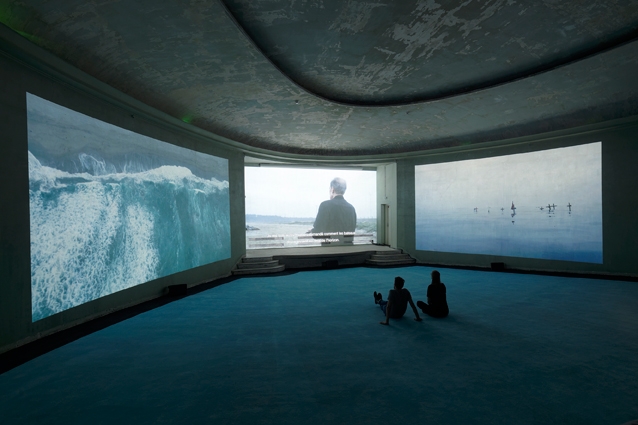“Buscar algo que no se ve…” (“Looking for something that can’t be seen…”), eighty-year-old actor and playwright Alejandro Sieveking mutters, in voiceover, at the beginning of Enrique Ramírez’s 15-minute video triptych, Los durmientes (all works 2014). Onscreen, in a single long take, the elder slowly walks his way down to a beach in Quintero, Chile, carrying a dead fish on his palms, as if about to return it to the sea. The title of the piece, which is also that of the exhibition, relates to the particularly gruesome circumstances of the murders of over 500 political opponents to General Pinochet following his 1973 military coup d’état. All of them, after being tortured by the Chilean secret police, were attached to lengths of railway track and thrown into the Pacific Ocean from helicopters, so that their remains would not resurface and their disappearances leave no trace. That is until the body of Marta Ugarte, a member of the Chilean Communist Party, washed up on a beach in Los Molles (Playa La Ballena) in 1976, and later in 2004, following the testimony of retired military officials on trial, a couple of railroad ties were found offshore in Quintero, giving more (yet so very little) evidence of the unspeakable atrocity that occurred during the dictatorship era.
In this exhibition, Ramírez – who grew up under Pinochet’s military regime – doesn’t investigate the death flights per se but offers a heartrending visual allegory of the trauma his nation has suffered ever since. For the lack of incriminating clues and the memory ‘loss’ of the perpetrators and witnesses have ensured that most crimes committed at the time remain unchallenged to this day, leaving the effort and duty of remembrance open like a permanent wound. In the 11-minute video loop Bell UH-1D Iroquois, the artist subtly addresses the deadlock that justice faces in regards to those ‘missing’ – the Iroquois being a helicopter that, unlike the Puma models operated by the Chilean death squads, is specifically used for medical evacuations. Only here, with no site to check and no body to be found, no rescue can be attempted: the chopper slowly takes o¡, turns around itself three times and lands right back where it was, endlessly. Next to this, Latitudes, a series of 30 engraved sheets of black glass, each A4 size, presents imaginary mappings of the locations (marked by white dots) where the victims disappeared. With no geographical indications except the north arrow, the compositions are captioned with quotations from newspapers and the 1991 report of the Chilean National Commission for Truth and Reconciliation, which, it states, ‘arrived at a moral conviction that the so-called “disappearance” is not a disappearance at all’.
Echoing the introductory wall text of the show, which reads, ‘The sea is Chile’s true graveyard’, the two-minute video Pacífico is a silent, static shot above the ocean. Recorded at 60 frames per second, the result is petrifying: powerful waves unrelentingly kneading the surface render the dark waters distressingly gloomy and impenetrable. Back to the long shot of Sieveking walking down the beach in Quintero, the middle panel of the video triptych Los durmientes: once he reaches the sea, he momentarily disappears behind a stranded fishing boat to give way to a younger man (played by actor Jorge Becker) carrying a body bag in place of the former’s dead fish. In the meantime, a helicopter takes off on the left panel and flies over the ocean, while the right panel shows an ephemeral sea graveyard, floating crosses tossed by the tide.
With no disruption, Becker keeps going along the shore, his steps only paced by his poetic voiceover: “Fabrica la vida… el silencio… el miedo… la búsqueda…” (“Fabricate life… silence… fear… quest…”), in other words the very paradox that paralyses Chilean society with regard to uncovering its tragic history. Finally he enters the ocean, where the old man waits for him. As they exchange dead fish and body bag in a final, poignant embrace, the camera is brutally thrown from the helicopter of the left panel into the deep waters and the image turns black. Ni olvido, ni perdón.
This article was first published in the January & February 2015 issue.
